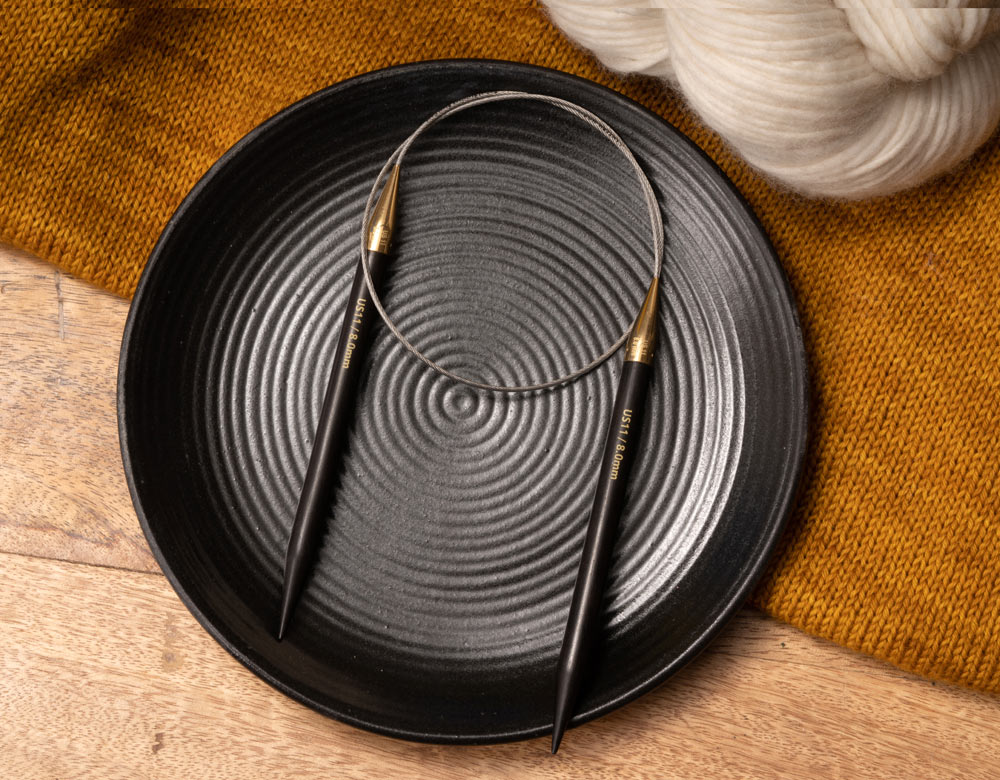
Knitting is fun. It’s exciting to make something by hand. However, when you are learning, it can also make you a bit tense. You want everything to come out perfectly. You might find yourself gripping the knitting needles intensely and pulling the yarn tight. You’re concerned that the stitches will fall off, so you’re being extra careful. When this occurs, your knitting may become too tight and the stitches can be harder to work. Relax! Take a breath and remember: Knitting is forgiving. Approach the craft with a gentle spirit and it will reward you many times over.
In the meantime, here are a few tricks of fixing tight stitches. While theses tricks work on almost all types of needles, in this blog we’ll be discussing the tricks for fixing and avoiding tight stitches on circular knitting needles.
1. Change your gear, change your game
Consider changing the size of your knitting needles. You can switch to a slightly larger pair of needles – just 0.5mm can make a difference. For example if you are using US 8 (5mm) switch to US 9 (5.5mm) Remember to watch the gauge swatch, however. If you are following a pattern, then make sure you have the exact measurements.
This tip is good for circular knitting as well as for knitting back and forth. It is especially important to not have tight stitches when working on circular needles. At the joint (where knitting needle joins the cord) – where the cable is attached to the needle, there is a change in diameter. The needle tip is the correct size as mentioned a pattern or one that the yarn label suggest, but the cord is much thinner, be it fixed circulars or interchangeable ones. Thinking about the diameter of the needle tip can help you stay loose.

2. Give the whole needle some love
A lot of the time, tight-knitters will knit into their stitches using the tip of the needle without letting the stitch slide all the way onto the needle. When working on interchangeable circular knitting needles slide the stitches to the cord and back. The movement will also ensure that your stitches are not tight.
3. Switch Yarn Fiber
Just the way that needle size dictates gauge, it is also determined by the weight of the yarn. There are at least eight different kinds of yarn weights, ranging from lace to jumbo. If your yarn is even just one weight category heavier than what the pattern calls for, the stitches may be too tight. You can usually find what kind of needles the yarn calls for on the yarn’s label, so make sure your needle and yarn weight match relatively well. To be sure, of course, it is recommended that you do a gauge swatch before beginning any project.
There's also a chance that the fiber content of the yarn is affecting the tightness of your knitting. Some knitters may like acrylic yarn for its affordability and versatility, but it may not have a lot of “give”. This can be a problem with synthetic fibers since there is less flexibility with non-natural fibers.
4. Try a different knitting style
Knitting methods can also play a part in creating overly tight stitches. Consider the “Continental” method. It’s a style that involves "picking" the knitting yarn with your right-hand needle. This way, your tension is kept even by your left hand holding your working yarn as your right-hand scoops it up for the stitch. (There are many online tutorials for the Continental method.) This solution is recommended for knitters who have just started knitting. It may be easier to learn this style if you are just starting out. Experienced knitters can still change, but it will be a little more challenging since muscle memory has to be overcome.
You can also try out changing the needle types. If you are knitting on single pointed needles switch to circulars or vice versa as this too affects knitting comfort that is also another reason for tight stitches. On another thought, go through the pros and cons of knitting flat or circular.
Knitting is a bit like learning a new language and it takes time and practice to be fluent. So give it some time! Try to relax and treat knitting as a practice session. Once you become comfortable while knitting, you will naturally loosen up and relax.
So, ready to try these tricks? Make sure to take a look at our blog on choosing knitting needles, crochet hooks, accessories, techniques, tips and more.
